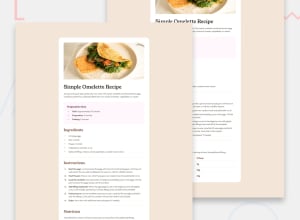
Design comparison
Solution retrospective
I was able use grid pretty well.
What challenges did you encounter, and how did you overcome them?After completing the Desktop part designing the mobile part was troublesome. So, I saw the mobile first workflow written in Readme-template and decided to make the mobile part first then use the media query to scale to desktop and it became easier to do.(I don't know actual mobile first workflow)
What specific areas of your project would you like help with?Should I design the desktop part first or the mobile part first? I want to know about the mobile-first workflow or similar workflow. If you can provide a good resource, please do so.
Community feedback
- @DylandeBruijnPosted 4 months ago
@Y-ashbhatt
Hiya! 👋
Congratulations on your solution, it looks very close to the design! I can tell you put a lot of effort into it.
To answer your question about mobile-first, begin by designing the layout and interface for the smallest possible screen size. This involves focusing on essential content and functionality, removing unnecessary elements, and ensuring text is readable.
Implement responsive design techniques to make the layout adjust automatically based on the screen size. This typically involves using CSS media queries to apply different styles for different screen widths:
/* Base styles for mobile */ body { font-size: 16px; } /* Styles for tablets and above */ @media (min-width: 768px) { body { font-size: 18px; } } /* Styles for desktops and above */ @media (min-width: 1024px) { body { font-size: 20px; } }Build a solid foundation with core content and functionality for mobile users, then add enhancements for larger screens. This ensures that even if users only see the mobile version, they still get a functional and engaging experience.
Regularly test your design on actual mobile devices to ensure it looks good and works well. Tools like browser developer tools can simulate various devices, but testing on real hardware is invaluable.
Ensure images, videos, and other media are optimized for mobile download speeds and resolutions. Techniques like responsive images and lazy loading can significantly improve performance.
In summary, mobile-first is about prioritizing the mobile experience, understanding its unique challenges and opportunities, and designing accordingly. It leads to more efficient development processes, better user experiences, and ultimately, more successful digital products.
I hope you find my feedback valuable, and I would appreciate it greatly if you could mark my comment as helpful if it was! 🌟
Let me know if you have more questions and I'll do my best to answer them. 🙋♂️
Happy coding! 😎
Marked as helpful1
Please log in to post a comment
Log in with GitHubJoin our Discord community
Join thousands of Frontend Mentor community members taking the challenges, sharing resources, helping each other, and chatting about all things front-end!
Join our Discord
